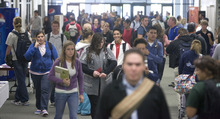This is an archived article that was published on sltrib.com in 2012, and information in the article may be outdated. It is provided only for personal research purposes and may not be reprinted.
After four straight years of strong enrollment gains, Utah's system of public colleges and universities tallied a 1.6 percent decline this fall, shedding about 2,700 students compared with last year.
The eight-institution system's 171,292 students are still nearly 15 percent more than were enrolled in 2008. Interestingly, the biggest declines this fall were recorded at the three open-admissions schools that have seen the steepest growth in recent years — Utah Valley University, Dixie State College and Salt Lake Community College — while enrollment climbed at other schools, according to data released Friday by the Utah State Board of Regents.
In the wake of the economic downturn, college enrollment climbed as people crowded into Utah's open-admission schools seeking to gain skills for a constricting job market. Now that the economy is improving, there is less pressure on the colleges, according to Commissioner of Higher Education Dave Buhler.
"I see this as a pause," Buhler said. "In some areas, it's capacity. Students haven't been able to get all the courses they need so they don't go forth on their education this year. I am not alarmed by it. In [full-time equivalence] we are dead even [with last fall]. This is something we won't want to see continue if we want to have an educated workforce."
Nationally, college enrollment struck an all-time high last year with nearly 25.8 million young adults in college,representing nearly half the high school graduates between ages 14 and 24, according to new data from the U.S. Census. A decade earlier that portion was 44.1 percent.
Dixie State, which is on track to become a university in the next few years, may have dropped more than 200 students, but its enrollment remains almost 40 higher than it was only four years ago.
UVU President Matthew Holland attributed the 5.5 percent drop at his Orem campus to new policies implemented to ensure incoming students are better prepared — such as "structured enrollment," which requires applicants to meet certain grade-point average and ACT test score thresholds to gain full university admission.
"We were expecting a dip this year. We have an earlier and firmer admissions deadline, we beefed up the purge process, and we have pulled back on concurrent enrollment," Holland said. "We still embrace open admissions. But it was clear that we would have to get thoughtful and get intentional in the way we admit students so that the growth we take is quality growth and the students who come here are serious."
SLCC, which saw its enrollment soar as the recession persisted, experienced another big swing, this time losing 3,000 students — at least on paper.
The numbers released Friday represent a "snapshot"of each school's enrollment during the third week of classes in early September. They don't account for students taking non-credit, short-term vocational courses, nor the more than 2,000 credit-seeking students expected to enroll in SLCC's eight-week mini-semester, which starts Wednesday.
"Because of the way we are nimble and flexible to serve a broad mission, it doesn't always capture what we are doing," press officer Joy Tlou said.
Buhler wondered whether SLCC's 2008-09 enrollment boom is now helping drive growth at the University of Utah, where many SLCC graduates pursue bachelor's degrees.
The U. and Southern Utah University both recorded modest enrollment bumps — despite tightened admissions standards — as did open-admission Weber State University and Snow College. SUU's Cedar City campus gained 550 students for a 7 percent increase. This fall's crop of freshmen is the largest and most academically prepared in school history, officials said.
"As we continue to refine and improve the liberal arts education we deliver at SUU, we find more students and parents excited to be a part of our campus," SUU President Michael Benson said. "This healthy and planned growth is precisely where we want to be."
On Utah's two selective private campuses, enrollment climbed about one point at Brigham Young University and remained flat at Westminster College. A majority of the freshmen at both schools come from out of state.
Some officials foresee enrollments slipping at colleges across Utah in coming months and years as students opt for Mormon missions after the LDS Church's recent announcement lowering the minimum age of full-time missionary service to 18 for men (down from 19) and 19 for women (down from 21).
The U. regained its status as the state's largest public student body at 32,400, slightly behind BYU. Officials said more students are returning to resume their studies, indicating that efforts to boost retention are paying off. But the U. is also doing a better job advertising itself as a premier academic destination, according to Mary Parker, the U.'s vice president for enrollment management.
"We've really talked about what's happening. We have programs that are highly ranked and faculty winning national awards," Parker said. "Our goal for the next few years is to grow 1 to 2 percent a year. Student success is President [David] Pershing's No. 1 priority. We are making sure we are recruiting and admitting the right students and when we get them here, they will have what it takes to be successful. These numbers are reflecting that." —
Utah's selective private colleges
Brigham YoungUniversity
Total fall enrollment in 2011 • 32,947
Total fall enrollment in 2012 • 33,336
Change • Up 1.2 percent
Westminster College
Total fall enrollment in 2012 • 3,355
Total fall enrollment in 2011 • 3,352
Unchanged



